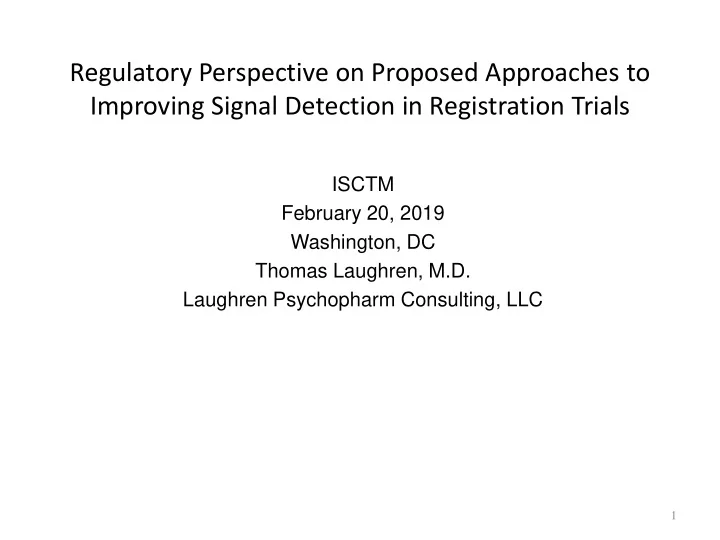

Regulatory Perspective on Proposed Approaches to Improving Signal Detection in Registration Trials ISCTM February 20, 2019 Washington, DC Thomas Laughren, M.D. Laughren Psychopharm Consulting, LLC 1
Active Consulting Relationships with Pharmaceutical Companies and Employment Relationship with MGH CTNI • Part time employee of MGH CTNI • Consultant to Abide, Acadia, AeviGenomics, Alzheon, Antares, Astellas, Axovant, Axsome, AZ Therapeutics, Biohaven, CogRx, Concert, Cox Bioscience, Evecxia, Greenwich, Harmony, Janssen, Karuna, KemPharm, LB Pharm, Lilly, Lyndra, MAPS, Marinus, Merck, Minerva, MVK Pharm, Neurocrine, Neurolifesciences, Noven, Ovid, Purdue Pharma, Rhodes, Roche, Tonix, Vallon, Vanda 2
Proposed Approaches for Improving Signal Detection • Improving patient selection • Reducing fraudulent patients • Improving severity ratings • Better rating instruments* • Improving patient adherence • Reducing trial complexity • Improved trial design* • Better oversight by sponsor 3
Excluding Randomized Patients from Analysis • When is this ok?—basing exclusion on data collected prior to randomization – Antibiotic trial where need culture results – Antidepressant trial where blind sites to severity threshold • When is it not ok?—basing exclusion on post-randomization findings – Excluding sites with large placebo response – Excluding patients who don’t adhere to treatment 4
What about duplicate subjects? • If discover after randomization, still need to include in analysis, but do sensitivity analyses to try to understand any possible impact 5
Better Rating Instruments • Of course, a good idea if existing instruments are not optimal • Challenges – Need to establish validity (and hopefully reliability) – Growing challenge of dealing with Clinical Outcomes Assessment (COA) group at FDA – Challenge of having an opportunity to discuss new instrument with FDA apart from routine meeting that is focused around a particular IND 6
Mythology promoted by some companies regarding sources of resistance to innovation • FDA and other regulatory agencies sometimes blamed for resisting innovation, when in fact comes from within the company itself – Deep conservatism about changing anything about trial conduct that might have worked in signal detection in the past – Protection of propriety interest in methodologies developed and used within a company 7
Failed vs Negative Studies • Failed study: has active control, and both new drug and active control fail to beat placebo • Negative study: no active control (so just new drug vs placebo), and fails to separate • An old idea, with some traction in the past, but maybe less so now • Better (in my view) to think about data in the aggregate – Worry less about strict statistical significance, more about effect size, confidence intervals, and direction of data overall – E.g., 4 studies, only 1 strictly significant at 0.05, but all 4 leaning in same direction, effect sizes consistent, confidence intervals consistent; can make case for approval 8
Designs to Address Placebo Response • Single blind placebo run-in • Delayed start design – Double blind placebo run-in • Sequential parallel comparison design (SPCD) 9
Sequential Parallel Comparison Design (SPCD) Structure Active Active Stage 2 Stage 1 First Placebo Placebo responders Randomizati Stage 2 on Placebo Stage 1 Active Re- Placebo Stage 2 non- randomizati Placebo responders on Stage 2 Primary efficacy analysis set Stage 1 Stage 2 Fava et al, Psychother Psychosom. 2003; 72(3): 115-27
Pros and Cons of Excluding Placebo Responders • Argument for: Evidence seems to suggest that may improve signal detection • Argument against: Doing this may reduce generalizeability of trial • Basic tension between pragmatic trial and explanatory trial – Other nomenclature is effectiveness vs efficacy – Registration trials error on side of being explanatory (or efficacy) trials 11
Lack of Evidence for “Efficacy” of Approaches to Improving Signal Detection Include as sub-study in registration trial • • Basically 2 x 2 factorial design • Assume 2 main groups, drug vs pbo; then add “signal detection approach” as another factor, and stratify on this factor, i.e., half the sites get this approach in addition to assigned treatment • Primary outcome would still be overall sample (drug vs pbo), but could also test efficacy of “signal detection approach” • Question: Does “signal detection approach” improve drug/pbo separation? Might do for adherence measures, patient selection approaches, • centralized rating, etc. 12
Recommend
More recommend